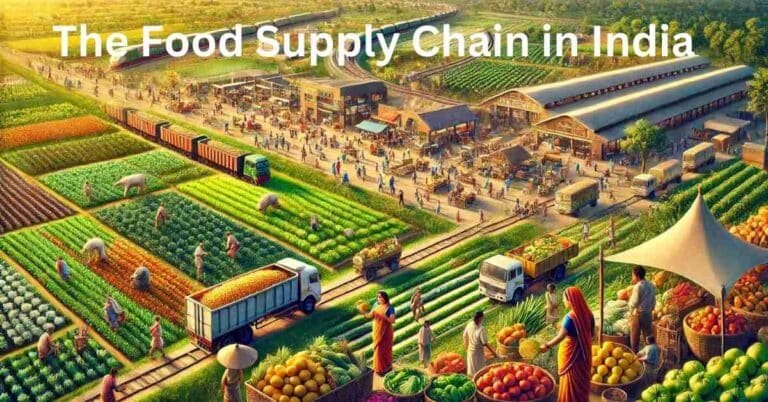When we think about the “food supply chain in India,” we’re diving into one of the most intricate and vital systems supporting over 1.4 billion people. From farmers cultivating crops in remote areas to consumers enjoying meals in bustling cities, this chain seamlessly connects production, storage, transportation, and consumption—all while grappling with challenges like wastage, sustainability, and economic impact. Let’s explore how this system operates, why it’s essential, and the innovations shaping its future.
India’s food supply chain is a web of interconnected activities. At its heart are the farmers—the system’s backbone— producing crops, dairy, and meat. Agriculture remains a crucial sector, with smallholder farmers producing raw materials like grains, fruits, and vegetables. They also rear animals for dairy and meat products, ensuring a consistent supply of essential food items. However, modern challenges such as spoilage, compliance with safety standards, and environmental issues demand new approaches.
Table of Contents
What is the Food Supply Chain in India?
India’s food supply chain involves a complex production, processing, and distribution system that ensures food reaches consumers efficiently. Farmers, processors, transporters, and retailers are key players in this chain. Each step focuses on handling, packaging, and storage to maintain safety, quality, and compliance with environmental and safety regulations. The chain also emphasizes minimizing wastage, timely delivery, and addressing perishable conditions, ensuring edibility and freshness for consumers.
Sustainability in the Food Supply Chain
Sustainability is central to India’s food supply chain, addressing challenges like emissions from transportation, waste management, and environmental impact. Critical measures include eco-friendly packaging, renewable energy adoption, and efficient farming practices. By focusing on flexibility, modern technology, and sustainable methods, the supply chain ensures long-term productivity and reduces ecological strain.
Key Steps in the Food Supply Chain
The food supply chain comprises production, handling, storage, processing, transportation, distribution, retail, and consumption. At the production stage, farming practices focus on crop cultivation, rearing animals for dairy and meat, and utilizing modern technology for increased productivity. Handling and storage prioritize proper conditions to avoid contamination, spoilage, and waste, particularly for perishable items like dairy, fruits, and vegetables. Transportation and retail ensure these products reach consumers safely, timely, and efficiently.
The Role of Technology
Technology revolutionizes India’s food supply chain by enhancing transparency, tracking, and efficiency. Blockchain enables traceability, while IoT devices provide real-time monitoring of storage conditions to prevent spoilage. Automation and digital platforms empower stakeholders, from farmers managing inventory to transporters ensuring optimal logistics. These advancements make the supply chain resilient and adaptable to market demands.
Collaboration and Connectivity
The effectiveness of India’s food supply chain relies heavily on coordination among stakeholders. Transporters, retailers, processors, and consumers all play pivotal roles. Improved roadways, railways, and digital connectivity reduce disruptions and ensure timely product delivery. Public-private partnerships (PPPs) foster collaboration, driving innovations that make the system more resilient.
Reducing Wastage and Enhancing Efficiency
With over 40% of food in India lost due to inefficiencies, reducing wastage is paramount. Sustainable practices, like better transport systems and cold storage, extend shelf life and minimize losses. Policies like the Public Distribution System (PDS) and subsidies for farmers ensure equitable access to food while stabilizing market prices.
Tailored Solutions for Market Segments
Different market segments require customized approaches. Continuous flow supply chains ensure the constant availability of grains and dairy products in stable demand. Agile supply chains handle perishable items, adapting quickly to market fluctuations. Flexible systems balance cost-efficiency and responsiveness, catering to diverse product needs.
Empowering Farmers and Supporting Innovation
India’s smallholder farmers are at the core of the supply chain. Initiatives like training programs, co-operatives, and subsidies empower them to adopt modern farming methods. Mechanization and real-time data analysis improve productivity, while innovations in packaging and labeling enhance product quality and marketability.
Conclusion
The food supply chain in India is a testament to resilience, innovation, and collaboration. By addressing challenges such as wastage, inefficiencies, and environmental impact, the system can evolve to meet the needs of a growing population. With technology driving transparency, coordination, and sustainability guiding practices, India’s food supply chain promises a healthier, more equitable future for all. From farm to fork, every link in the chain plays a role in ensuring that food reaches every corner of the country efficiently and sustainably.
FAQs
1. What is the food supply chain in India?
The food supply chain in India is a system that connects farmers, processors, transporters, and retailers to deliver food from farms to consumers, ensuring safety, quality, and efficiency.
2. Why is the food supply chain critical in India?
It ensures food security for over 1.4 billion people, minimizes wastage, supports farmers’ livelihoods, balances supply and demand, and stabilizes food prices.
3. What are the challenges in India’s food supply chain?
Key challenges include infrastructure gaps, high wastage, compliance with food safety regulations, limited cold storage facilities, and inefficiencies in transportation.
4. How is technology transforming the food supply chain?
Technologies like blockchain, IoT, and digitization improve transparency, real-time tracking, efficiency, and reduced wastage by optimizing processes.
5. How can the food supply chain in India be improved?
Improvements include investing in cold storage, enhancing transport infrastructure, adopting sustainable practices, and leveraging technology for better coordination and efficiency.


